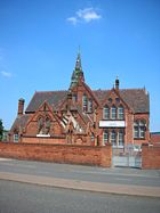
Birmingham board schools
Encyclopedia
__notoc__
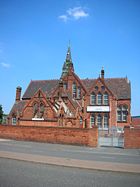
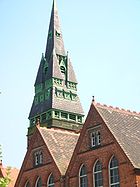
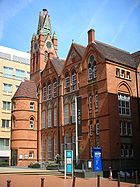
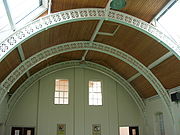 The Birmingham board schools were set up very rapidly after the Forster
The Birmingham board schools were set up very rapidly after the Forster
Elementary Education Act 1870
was enacted, covering England and Wales
. Over forty were created in Birmingham
.
, Member of Parliament (MP)
for Birmingham
, and Joseph Chamberlain
, mayor of Birmingham, both nonconformists, were leaders of the National Education League
and campaigners in the 1860s and 1870s for the provision of education free of influence by the churches. The Anglicans and Catholic
Churches were in control of the existing voluntary schools, and controlled the religious education of those who attended. The Liberals and Dissenters wanted compulsory education without religious doctrine. In the end the Elementary Education Act 1870 was a compromise filling in the gaps of the voluntary system.
The Act allowed each municipality to:
The first Birmingham board was created on 28 November 1870 and included nonconformists Joseph Chamberlain
, George Dawson
and R. W. Dale
. The School Board office was at 98 Edmund Street
.
J.H. Chamberlain
's firm Martin & Chamberlain
(no relation of Joseph Chamberlain) was appointed architect for the new schools from the beginning. The ambitious building plan achieved:
The school boards were abolished by the Balfour Education Act 1902
which established Local Education Authorities.
system, with fresh air being drawn in from above the polluted ground level, heated if necessary, and vented also from the tower. The tower was typically placed over the staircase to draw air through the school. There were terracotta plaques, glazed tiles, ornamental ironwork, tall windows, and stained glass. Martin & Chamberlain worked for low remuneration to enable a healthy education. The Pall Mall Gazette
in 1894 stated:
Some of the schools are still in use as schools, some have other uses, and some have been demolished. Good examples are the Icknield Street School
near the Hockley
Flyover, north of the Jewellery Quarter
, and Oozells Street Board School
, now the Ikon Gallery
.




William Edward Forster
William Edward Forster PC, FRS was an English industrialist, philanthropist and Liberal Party statesman.-Early life:...
Elementary Education Act 1870
Elementary Education Act 1870
The Elementary Education Act 1870, commonly known as Forster's Education Act, set the framework for schooling of all children between ages 5 and 12 in England and Wales...
was enacted, covering England and Wales
England and Wales
England and Wales is a jurisdiction within the United Kingdom. It consists of England and Wales, two of the four countries of the United Kingdom...
. Over forty were created in Birmingham
Birmingham
Birmingham is a city and metropolitan borough in the West Midlands of England. It is the most populous British city outside the capital London, with a population of 1,036,900 , and lies at the heart of the West Midlands conurbation, the second most populous urban area in the United Kingdom with a...
.
Elementary Education Act 1870
George DixonGeorge Dixon (MP)
George Dixon was English Liberal politician who was active in local government in Birmingham and sat in the House of Commons in two periods between 1867 and 1898. He was a major proponent of education for all children.-Life:...
, Member of Parliament (MP)
Member of Parliament
A Member of Parliament is a representative of the voters to a :parliament. In many countries with bicameral parliaments, the term applies specifically to members of the lower house, as upper houses often have a different title, such as senate, and thus also have different titles for its members,...
for Birmingham
Birmingham
Birmingham is a city and metropolitan borough in the West Midlands of England. It is the most populous British city outside the capital London, with a population of 1,036,900 , and lies at the heart of the West Midlands conurbation, the second most populous urban area in the United Kingdom with a...
, and Joseph Chamberlain
Joseph Chamberlain
Joseph Chamberlain was an influential British politician and statesman. Unlike most major politicians of the time, he was a self-made businessman and had not attended Oxford or Cambridge University....
, mayor of Birmingham, both nonconformists, were leaders of the National Education League
National Education League
The National Education League was a political movement in England and Wales which promoted elementary education for all children, free from religious control....
and campaigners in the 1860s and 1870s for the provision of education free of influence by the churches. The Anglicans and Catholic
Catholic
The word catholic comes from the Greek phrase , meaning "on the whole," "according to the whole" or "in general", and is a combination of the Greek words meaning "about" and meaning "whole"...
Churches were in control of the existing voluntary schools, and controlled the religious education of those who attended. The Liberals and Dissenters wanted compulsory education without religious doctrine. In the end the Elementary Education Act 1870 was a compromise filling in the gaps of the voluntary system.
The Act allowed each municipality to:
- elect a school boardSchool board (England & Wales)School boards were public bodies in England and Wales between 1870 and 1902, which established and administered elementary schools.School boards were created in boroughs and parishes under the Elementary Education Act 1870 following campaigning by George Dixon, Joseph Chamberlain and the National...
- raise money by local taxation
- require attendance between the ages of five and thirteen, by bye-law, a local option
The first Birmingham board was created on 28 November 1870 and included nonconformists Joseph Chamberlain
Joseph Chamberlain
Joseph Chamberlain was an influential British politician and statesman. Unlike most major politicians of the time, he was a self-made businessman and had not attended Oxford or Cambridge University....
, George Dawson
George Dawson (preacher)
George Dawson was an English nonconformist minister.-Ministry:He was born in London and educated at Marischal College, Aberdeen, and the University of Glasgow....
and R. W. Dale
Robert William Dale
Robert William Dale was an English Congregationalist church leader.-Life:Dale was born in London and educated at Spring Hill College, Birmingham, for the Congregational ministry...
. The School Board office was at 98 Edmund Street
Edmund Street
__notoc__Edmund Street is a street located in Birmingham, England.Edmund Street is one of a series of roads on the old Colmore Estate which originally stretched from Temple Row in the city centre, around St Phillip's Cathedral, to the northern end of Newhall Street. Originally the estate surrounded...
.
J.H. Chamberlain
John Henry Chamberlain
John Henry Chamberlain , generally known professionally as J H Chamberlain, was a nineteenth century English architect....
's firm Martin & Chamberlain
Martin & Chamberlain
John Henry Chamberlain, William Martin, and Frederick Martin were architects in Victorian Birmingham, England. Their names are attributed singly or pairs to many red brick and terracotta buildings, particularly 41 of the forty-odd Birmingham board schools made necessary by the Elementary Education...
(no relation of Joseph Chamberlain) was appointed architect for the new schools from the beginning. The ambitious building plan achieved:
- 5 schools in 1873
- 2 in 1874
- 3 in 1875
- 6 in 1876
- 6 in 1877
- 9 more in the next six years.
The school boards were abolished by the Balfour Education Act 1902
Education Act 1902
The Education Act 1902 , also known as Balfour's Act, is an Act of the Parliament of the United Kingdom affecting education in England and Wales. At the time of passage of the Act, the Conservative Party was in power...
which established Local Education Authorities.
Three departments - infants, girls, boys
Schooling in this era strictly segregated boys from girls, with separate head teachers, class rooms, playgrounds, and entrances from the road. Boys and girls may have been on different floors. There was usually a third department for infants. Teaching was by a combination of formal teaching of large numbers by the head teacher in a main hall, with galleries to allow the whole department to attend, and tuition by pupil-teachers and assistant teachers in side classrooms. There were glazed or open partitions so that all teaching could be supervised by the head.Architecture
Chamberlain believed that the architecture of schools should provide a pleasant contrast from the drab homes and environment of their pupils. The Chamberlain schools were designed for hygiene, light, fresh air and beauty. Typically in red brick and terracotta, gabled, with steep roofs supported by large arches of internally-exposed ironwork, and freely planned, they were towered to provide ventilation using the PlenumPlenum chamber
A plenum chamber is a pressurised housing containing a gas or fluid at positive pressure . One function of the plenum can be to equalise pressure for more even distribution, because of irregular supply or demand...
system, with fresh air being drawn in from above the polluted ground level, heated if necessary, and vented also from the tower. The tower was typically placed over the staircase to draw air through the school. There were terracotta plaques, glazed tiles, ornamental ironwork, tall windows, and stained glass. Martin & Chamberlain worked for low remuneration to enable a healthy education. The Pall Mall Gazette
Pall Mall Gazette
The Pall Mall Gazette was an evening newspaper founded in London on 7 February 1865 by George Murray Smith; its first editor was Frederick Greenwood...
in 1894 stated:
- In Birmingham you may generally recognize a board school by its being the best building in the neighbourhood. In London it is almost vice versa. With lofty towers which serve the utilitarian purpose of giving excellent ventilation, gabled windows, warm red bricks and stained glass, the best Birmingham board schools have quite an artistic finish. In regard to light and air the worst schools are equal to the best in London.
Some of the schools are still in use as schools, some have other uses, and some have been demolished. Good examples are the Icknield Street School
Icknield Street School
Icknield Street School , near the Hockley Flyover, north of the Jewellery Quarter, Birmingham, England, is a good example of a Birmingham board school....
near the Hockley
Hockley, Birmingham
Hockley is a central inner-city district in the city of Birmingham, England. It lies about one mile north-west of the city centre, and is served by the Jewellery Quarter station...
Flyover, north of the Jewellery Quarter
Jewellery Quarter
The Jewellery Quarter is an area of Birmingham City Centre, England, situated in the south of the Hockley area. It is covered by the Ladywood district. There is a population of around 3,000 people in a area....
, and Oozells Street Board School
Oozells Street Board School
Oozells Street Board School was a Victorian board school in Oozells Street, off Broad Street in Birmingham, England.Designed in 1877 by local architects Martin & Chamberlain, responsible for over forty of the Birmingham board schools, it opened on 28 January 1878 to serve 807 primary children.In...
, now the Ikon Gallery
Ikon Gallery
The Ikon Gallery is an English gallery of contemporary art, located in Brindleyplace, Birmingham. It is housed in the Grade II listed, neo-gothic former Oozells Street Board School, designed by John Henry Chamberlain in 1877. The gallery's current director is Jonathan Watkins.Ikon was set up to...
.
Sources
- Educational Documents, England and Wales 1816 to the present day, J Stuart MacLure, 1965, 1979, ISBN 0-416-72810-3
- Education in Britain 1750-1914, W B Stephens, 1998, ISBN 0-333-60512-8
- The English School, its architecture and organization Volume II 1870-1970, Malcolm Seaborne and Roy Lowe, 1977, ISBN 0-7100-8408-0
- Nine Famous Birmingham Men, edited J. H. Muirhead, Cornish Brothers Ltd., Birmingham, 1909, Article by George H. Kenrick.

